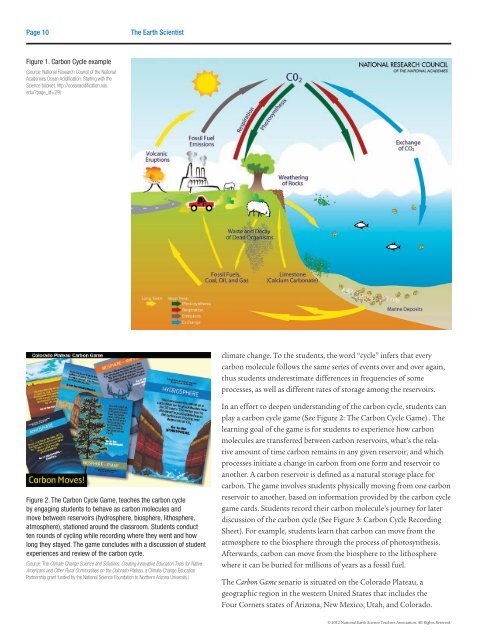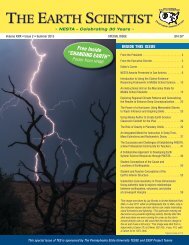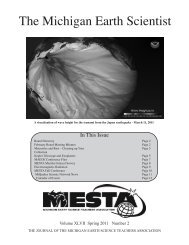The Earth Scientist
Fall 12.pdf - NESTA
Fall 12.pdf - NESTA
- No tags were found...
Create successful ePaper yourself
Turn your PDF publications into a flip-book with our unique Google optimized e-Paper software.
Page 10<br />
<strong>The</strong> <strong>Earth</strong> <strong>Scientist</strong><br />
Figure 1. Carbon Cycle example<br />
(Source: National Research Council of the National<br />
Academies Ocean Acidification: Starting with the<br />
Science booklet, http://oceanacidification.nas.<br />
edu/?page_id=29)<br />
climate change. To the students, the word “cycle” infers that every<br />
carbon molecule follows the same series of events over and over again,<br />
thus students underestimate differences in frequencies of some<br />
processes, as well as different rates of storage among the reservoirs.<br />
Figure 2. <strong>The</strong> Carbon Cycle Game, teaches the carbon cycle<br />
by engaging students to behave as carbon molecules and<br />
move between reservoirs (hydrosphere, biosphere, lithosphere,<br />
atmosphere), stationed around the classroom. Students conduct<br />
ten rounds of cycling while recording where they went and how<br />
long they stayed. <strong>The</strong> game concludes with a discussion of student<br />
experiences and review of the carbon cycle.<br />
(Source: <strong>The</strong> Climate Change Science and Solutions: Creating Innovative Education Tools for Native<br />
Americans and Other Rural Communities on the Colorado Plateau, a Climate Change Education<br />
Partnership grant funded by the National Science Foundation to Northern Arizona University.)<br />
In an effort to deepen understanding of the carbon cycle, students can<br />
play a carbon cycle game (See Figure 2: <strong>The</strong> Carbon Cycle Game) . <strong>The</strong><br />
learning goal of the game is for students to experience how carbon<br />
molecules are transferred between carbon reservoirs, what’s the relative<br />
amount of time carbon remains in any given reservoir, and which<br />
processes initiate a change in carbon from one form and reservoir to<br />
another. A carbon reservoir is defined as a natural storage place for<br />
carbon. <strong>The</strong> game involves students physically moving from one carbon<br />
reservoir to another, based on information provided by the carbon cycle<br />
game cards. Students record their carbon molecule’s journey for later<br />
discussion of the carbon cycle (See Figure 3: Carbon Cycle Recording<br />
Sheet). For example, students learn that carbon can move from the<br />
atmosphere to the biosphere through the process of photosynthesis.<br />
Afterwards, carbon can move from the biosphere to the lithosphere<br />
where it can be buried for millions of years as a fossil fuel.<br />
<strong>The</strong> Carbon Game senario is situated on the Colorado Plateau, a<br />
geographic region in the western United States that includes the<br />
Four Corners states of Arizona, New Mexico, Utah, and Colorado.<br />
© 2012 National <strong>Earth</strong> Science Teachers Association. All Rights Reserved.






